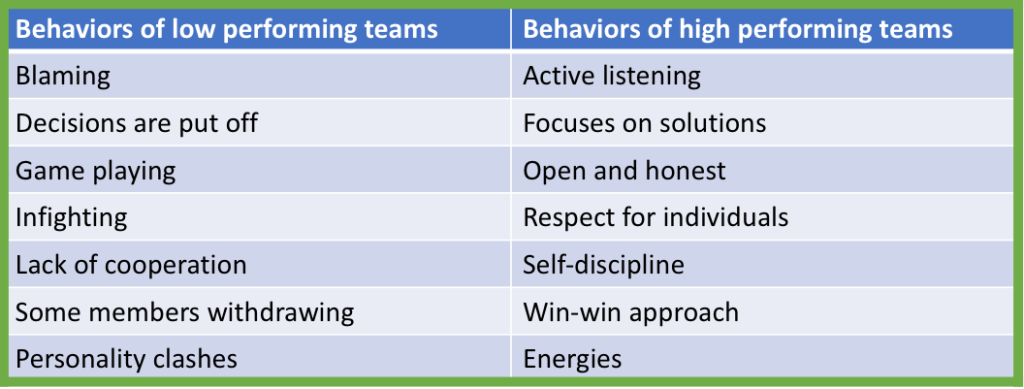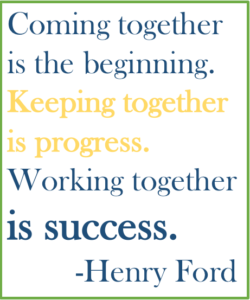
Here we will discuss the different phases workplace teams go through and offer suggestions on to how to build cohesion with your team and solve workplace conflicts and increase team production.
A Common Goal
Every business be it a small family endeavor or a large corporation desires a team that will work together, respect one another and solve the problems that arise in daily operations.
Team cohesion is the extent to which the members within a group are attracted to the ideas held by the group. In the work environment, it is important for all employees to share a common goal, namely, to complete tasks that will benefit the company or organizational group. Having employees work toward a common goal promotes an interdependency among the coworkers; if each team member does their part, the task will ultimately come together.
A cohesive work environment increases the likelihood of employee satisfaction and serves as an incentive for employees to arrive prepared and willing to conquer the tasks of the day. Lack of cohesion within a working environment is certain to result in unnecessary stress and tension among coworkers. As might be expected, when employees do not get along together, work suffers. Thus, cohesion in the work place could, ultimately, be the rise or demise of an organization or company’s success.
 Examples of low and high functioning behaviors
Examples of low and high functioning behaviors
Team Building Processes
Prior to entering into a group, team members usually differ in many aspects, including personal background, work ethic, attitude, and commitments. To best ensure cohesion and increase productivity for the group as a whole, team members must go through a process to establish a common ground.
Tuckman published an article way back in 1965, identifying and explaining the critical stages of building and developing groups. These stages are still relevant and explain the process of group unification and cohesiveness in the workplace today.
Tuckman’s Stages
Forming: Group members learn about each other and the task at hand. Indicators of this stage might include: unclear objectives, limited involvement, uncommitted members, confusion, low morale, hidden feelings, poor listening, etc.
Storming: As group members continue to work, they will engage each other in arguments about the structure of the group. Such arguments often are significantly emotional and illustrate a struggle for status in the group. These activities mark the storming phase: lack of cohesion, subjectivity, hidden agendas, conflicts, confrontation, volatility, resentment, anger, inconsistency, and failure.
Norming: Group members establish implicit or explicit rules about how they will achieve their goal. They address the types of communication that will or will not help with the task. Indicators include: questioning performance, reviewing/clarifying objectives, changing/confirming roles, opening risky issues, assertiveness, listening, testing new ground, and identifying strengths and weaknesses.
Performing: Groups reach a conclusion and implement the solution to their issue. Group cohesiveness is developed. Indicators include: creativity, initiative, flexibility, open relationships, pride, concern for people, learning, confidence, high morale, success, etc. (Tuckman, 1965)
Understanding the root of group formation, as seen through the progression of stages, is an important element in maintaining cohesive relationships within the workplace; in fact, the development and maintenance of cohesive relationships within a given workplace is often and important key to a company’s success.
Building a Trusting Team
Among the most important factors in constructing group cohesion within a workplace is trust. Since individual employees possess their own values and beliefs, it can take time for each team member to develop trusting relationships with other coworkers.
Ultimately, trust enhances connectedness among coworkers and serves to promote group cohesion. Once trust is established, an employee is better able to focus on their individual tasks and trust that other employees abide by similar standards.
Steps You Can Take to Build Up Your Team

Now that we have discussed group cohesion and its contribution to the success of a team, it is important to recognize how an employer might promote group cohesion in his or her organization over time. Below are suggestions listed on how one might strive to establish and enhance cohesive relationships within the workplace:
1. Team Communication
- Create a sense of partnership
- Express your desire to work as a team
- Assume good intentions
- Focus on solutions
- Have open dialogue
2. Team Collaboration
- Put the team’s needs first
- Accept unpleasant tasks with a positive attitude
- Discourage competition
- Be proactive in finding ways to help the team
- Consider the team’s success as your own
3. Building trust
- Be supportive of your teammates
- Acknowledge their skills and their contributions
- Give others responsibility and let them make decisions
- Maintain confidentiality
- “Walk the talk”
- Take responsibility for your actions
- Share responsibility for the actions of your teammates
- Act consistently
- Say what you mean and mean what you say
- Give and receive constructive feedback, and
- Admit mistakes
Creating a well oiled and functional team can be a challenge for any business. Yet by applying a few strategies it is totally possible. Even for the most contentious of corporate cultures a cooperative team can be achieved.
By addressing communication a Team Leader/Manager can help cultivate a sense of ownership and encourage a solutions focused work environment, eliminating the often subtle conflict issues that can arise.
When we focus on inviting collaboration we can discourage the competition between employees and unlock the human potential that supports company profits.
As we support employees they will thrive as we acknowledge their skills and contributions. Setting an example by owning our own weaknesses and mistakes encourages our staff to do the same. Building trust within our corporate culture begins with consistent leadership.